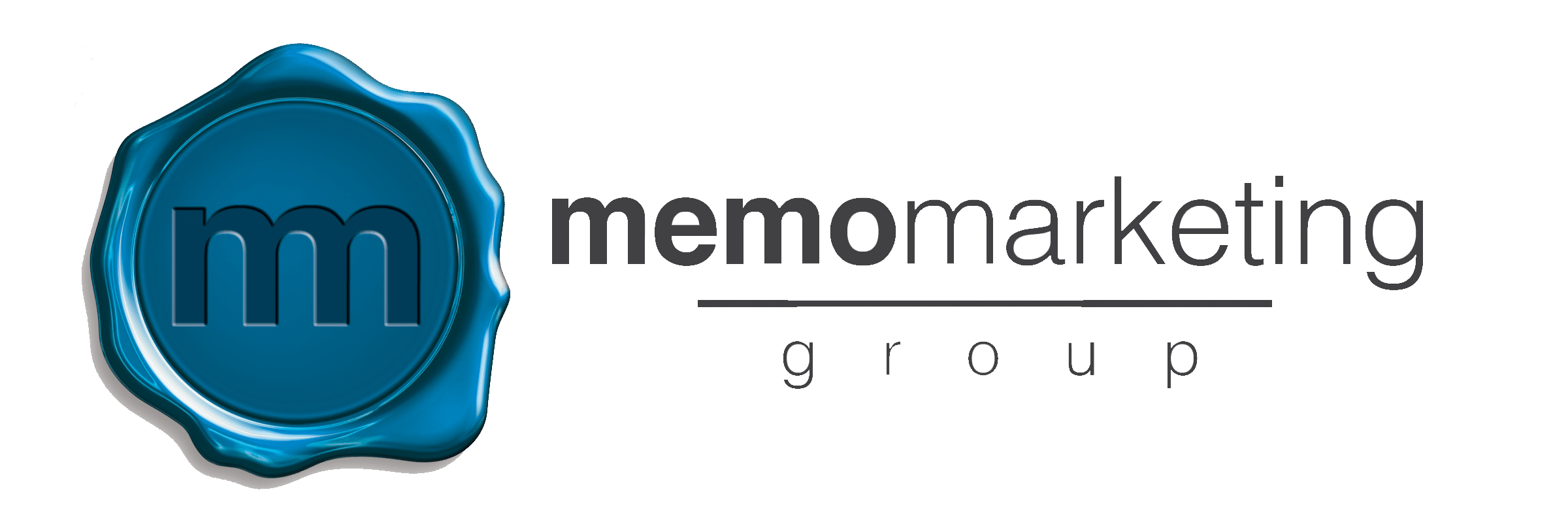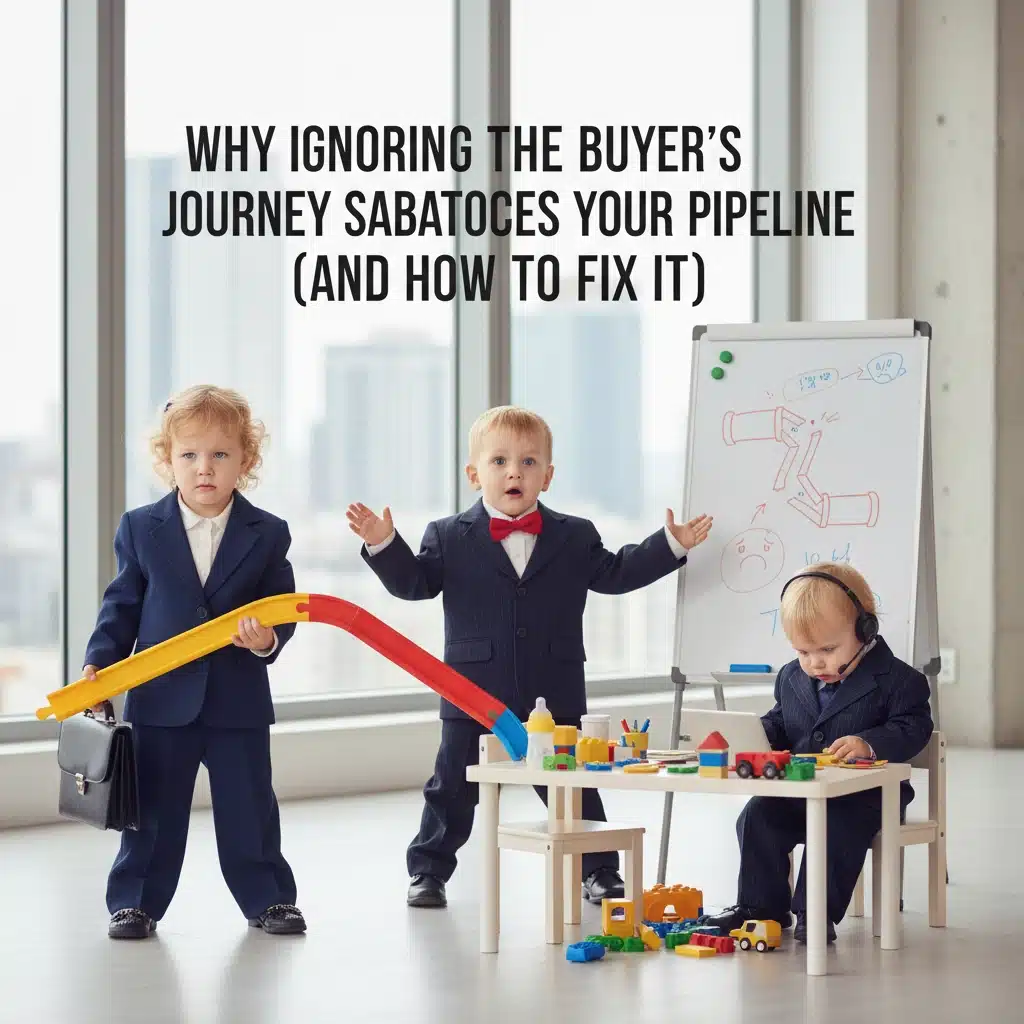Your marketing content is probably backwards. While you’re busy showcasing features, benefits, and package details, your prospects are asking completely different questions: “Do I even have a problem worth solving?” and “What options should I be considering?”
This disconnect between what you’re saying and what buyers need to hear creates a pipeline problem that most B2B companies don’t even realize they have. When your content only supports your internal sales process instead of addressing where prospects actually are in their journey, you’re missing opportunities to build trust, educate effectively, and nurture genuine relationships with potential customers.
Why Buyers Tune Out When You Talk About Your Sales Process
Most businesses organize their marketing around their own operational needs. Your content calendar reflects your sales stages: introductory content for first meetings, capability presentations for audits, detailed proposals for closing. This makes perfect sense internally, but it creates a fundamental problem.
Your prospects aren’t following your timeline. They’re navigating their own journey that looks nothing like your sales process.
While you’re ready to talk about your comprehensive service packages, they’re still figuring out whether their current approach is actually broken. When you’re highlighting competitive advantages, they’re trying to understand what solutions even exist in the market. This misalignment means your marketing content feels premature, irrelevant, or pushy to prospects who aren’t ready for it.

The buyer’s journey typically includes distinct phases: problem recognition, solution research, vendor evaluation, and decision-making. Each stage requires different types of information, different levels of detail, and different approaches to building confidence. When your content library skips the early stages and jumps straight to “why choose us,” you’re missing the opportunity to guide prospects through their natural progression.
Why Your Content Isn’t Sparking Real Conversations (Yet)
Trust Erosion Through Premature Positioning
When prospects encounter your content before they’re ready for it, you appear out of touch with their reality. Someone still questioning whether they need a solution at all will dismiss content about your implementation process or pricing tiers. This creates an immediate credibility gap that’s hard to recover from later in the relationship.
Recent research shows most B2B buyers don’t contact vendors until they’re deep into the process: 80% initiate first contact when they’re already about 70% through their journey (Demand Gen Report, citing 6sense’s 2024 Buyer Experience Report). If your early-stage content doesn’t address their actual concerns, they’re forming negative impressions of your business before you even know they exist.
Missed Opportunities for Educational Leadership
The businesses that win in B2B marketing are those that help prospects understand their problems better than they understood them before. When your content library lacks educational pieces that address problem identification and solution exploration, you’re missing the chance to position yourself as a trusted advisor rather than just another vendor.
Prospects who discover helpful, educational content during their research phase are more likely to include you in their vendor evaluation process. Buyers are also forming preferences earlier: 94% of buying groups identify a preferred vendor before any contact, and they purchase from that preliminary choice 77% of the time (Morningstar coverage of 6sense’s 2025 Buyer Experience Report). They’ve already associated your brand with valuable insights, creating a foundation of trust that pure promotional content cannot establish.
Weak Lead Quality and Poor Conversion
Content that doesn’t align with buyer journey stages attracts the wrong type of engagement. Prospects who aren’t ready for solution-focused content might engage superficially but won’t convert to meaningful opportunities. Meanwhile, prospects who are ready to evaluate vendors might never find you because your early-stage content doesn’t address their initial research queries.
This creates a pipeline filled with poorly qualified leads who either aren’t serious about solving their problem or aren’t at the right stage to make purchasing decisions. Your marketing generates activity without generating progress.

Here’s What Happens When You Only Talk About Yourself
Competitive Disadvantage in Search and Discovery
When prospects research solutions online, they’re not searching for your product categories or service names. They’re searching for problem descriptions, symptom explanations, and solution comparisons. If your content doesn’t address these search behaviors, competitors with buyer-focused content will capture mindshare during the crucial early research phase.
Companies that invest in problem-focused and educational content consistently rank higher in search results for the queries prospects actually use. This search visibility advantage compounds over time, making it increasingly difficult to compete for organic discovery.
Inefficient Marketing Spend and Resource Allocation
Marketing budgets invested in promoting solution-focused content to problem-aware audiences generate poor returns. You’re paying to put advanced-stage content in front of early-stage prospects, creating expensive mismatches between message and audience readiness.
Content promotion becomes less effective when the content itself doesn’t align with where prospects are in their journey. This forces marketing teams to rely more heavily on paid acquisition and outbound tactics instead of building organic attraction through valuable educational resources.
Sales Team Friction and Longer Cycles
When marketing content doesn’t prepare prospects properly for sales conversations, your sales team inherits additional qualification and education responsibilities. Instead of building on a foundation of trust and understanding created by marketing, sales reps must start from scratch with basic problem identification and solution education.
This extends sales cycles unnecessarily and reduces the efficiency of your sales organization. In enterprise deals, buying cycles already average about 11 months and typically involve 6 to 10 decision makers, so forcing basic education late only slows things further (Demand Gen Report on 6sense’s 2024 Buyer Experience Report; Advertising Week summarizing Gartner). Marketing-qualified leads require more sales effort to convert, creating tension between teams and reducing overall pipeline velocity.
How Do You Make Your Content Fit the Actual Buyer Journey?
Stage 1: Help buyers spot the real problem
Your content library needs pieces that help prospects recognize and articulate problems they might not fully understand yet. This includes symptom-focused content, industry trend analyses, and diagnostic frameworks that help readers assess their current situation objectively.
Create content that addresses questions like “Is this normal?” and “Should I be concerned about this?” rather than jumping immediately to solution positioning. This early-stage content builds awareness and trust while positioning your organization as helpful rather than self-interested.
Stage 2: Teach the options (without the pitch)
Once prospects recognize they have a problem worth solving, they need to understand what types of solutions exist and how different approaches work. This is where educational content about methodologies, technology options, and strategic considerations becomes valuable.
Focus on helping prospects become smarter buyers rather than promoting your specific approach. Content that explains how to evaluate solutions, what questions to ask vendors, and what implementation considerations matter builds credibility and demonstrates expertise.

Stage 3: Make comparing you to others easy
At this stage, prospects are ready for content that helps them distinguish between different providers and approaches. This includes case studies, methodology comparisons, and decision frameworks that acknowledge the complexity of vendor selection.
Rather than simple competitive positioning, create content that helps prospects evaluate all their options more effectively. This approach demonstrates confidence in your solution while providing genuine value during the decision-making process.
Stage 4: De-risk the decision and build confidence
Final-stage prospects need content that addresses implementation concerns, change management considerations, and success factors. This content should focus on building confidence about achieving results rather than closing techniques or urgency creation.
Address common concerns about timing, resource requirements, and potential challenges. Prospects who feel confident about successful implementation are more likely to move forward and become advocates for your solution internally.
What Does a Buyer-Focused Content Strategy Actually Get You?
How to read the signals at each stage
Track how different types of content perform with prospects at various stages. Early-stage educational content should generate longer engagement times and social sharing. Mid-stage comparison content should drive consultation requests. Late-stage content should correlate with proposal requests and decision acceleration.
This measurement approach helps identify gaps in your content library and opportunities to better serve prospects at each stage of their journey.
See lead quality improve over time
Monitor how changes to your content strategy affect the quality of marketing-qualified leads. Better journey alignment should result in prospects who are more educated, more engaged, and more ready for meaningful sales conversations when they do request contact.
Track metrics like lead-to-opportunity conversion rates and average deal size to measure the business impact of buyer journey alignment.
Want a Stronger Sales Pipeline? Here’s Your Playbook
The most sustainable approach to B2B marketing focuses on becoming the resource prospects turn to throughout their journey. When you provide valuable insights at every stage, you build relationships that extend far beyond individual transactions.
Companies that excel at buyer journey alignment report 67% higher lead quality and 18% faster sales cycles compared to those using traditional product-focused content strategies. The investment in educational content creation pays dividends through stronger relationships, better-qualified opportunities, and more efficient sales processes.
If your current content library primarily showcases your capabilities rather than addressing buyer questions and concerns, you’re likely missing opportunities to build trust and guide prospects naturally toward your solution. Contact MEMO Marketing Group to evaluate your content alignment with actual buyer journey stages and identify specific opportunities to improve pipeline quality through educational marketing.

